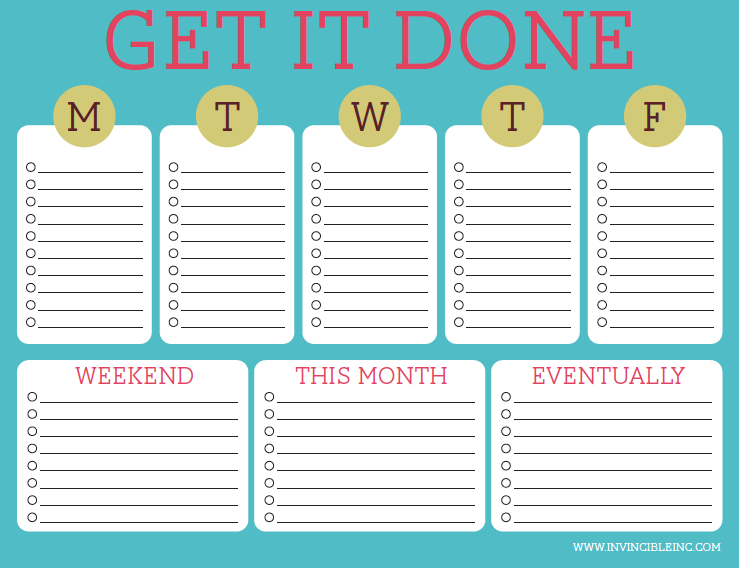This is Week 17 of a Year of Living Productively
This week I tested Another Simple and Effective Method of Mark Forster’s. I kept a paper task list, crossed off a task all the way across the page, and then did a task from each of the newly created sections of the list and so on. Scroll to the end of last week’s post for details.
How Another Simple and Effective Method of Mark Forster’s Saved My Sanity This Week
- Had me excited to get things done. I don’t test a method unless I really think there’s a potential for it increasing my productivity and this was no different. I began the week very motivated.
How Another Simple and Effective Method of Mark Forster’s Made Me Crazy This Week
- Couldn’t find the tasks. I made a list of 90+ tasks. That probably isn’t the best approach to take with this method. I frequently had to do tasks regardless of where they were on the list because they became urgent. I couldn’t find them then and it made the system super confusing once I did.
- Open task list. One of the things I’ve learned thus far is that I function better using a closed list (one in which no new tasks can be added). I found myself feeling very resistant to adding tasks to the end of the list. I wanted a list that kept shrinking. I disliked this aspect of the approach so much, that I quit using it halfway through the week.
- Competing interests. I haven’t been feeling well this week. (I know I keep mentioning this without explaining. When I have an answer, I will be sharing on the blog. Until then, know that I’m pretty sure what the problem is and it’s treatable.) When I don’t feel well, I tend to do the must-do’s only and I don’t want to mess with an approach like this one. Finally, I’m finding that I’m extremely motivated by my summer project list. After the critical issues, I haven’t wanted to do much of anything else but my weekly project. I have been in single focus mode and I suspect that I function best this way most of the time.
Did Another Simple and Effective Method Help Me Get More Done?
No. The open nature of the list and my circumstances this week didn’t work for me. Your mileage may vary.
**UPDATE**
I not only don’t use this approach, but I have had no desire to use a mammoth list of tasks to get things done for a long time.
The Productivity Approach I’ll Be Using for Week 18
This week I’ll be testing Agota Bialobzeskyte’s Daily/Weekly/Monthly To-Do List. I’ll begin with a closed list of monthly tasks to accomplish. I’ll base my closed weekly list of tasks on it and my daily list of tasks from the weekly list.
The concept. Agota has a problem with infinite to-do lists just like I do. She bases her approach on Scott Young‘s (who doesn’t use a monthly list). By not being allowed to add more tasks to the lists when they’re complete, you get a real feeling of accomplishment. By looking ahead for a month, you’re including tasks other than what’s right in front of you–enabling you to work ahead. Doing so enables one to feel on top of things.
If you’d like to join me this week, here’s what you do. Read Agota’s guest post on Productive Superdad, taking note of the FAQs at the end. Choose a means of making your lists. I’ll be using paper for the monthly and weekly goals and will have digital daily lists that I will print out. Create your weekly list by drawing from your monthly list. Each day (either the night before or morning of), create your daily list based on your weekly list. Cross off tasks as you do them. Like the list above? It’s not perfectly suited for this, but you can download it here.
Click here to see how my week with a daily/weekly/monthly to-do list went.
Are you on Pinterest? Follow my Organization and Productivity board.
If you’ve tried Another Simple and Effective Method to increase your productivity, please vote in the poll below.
Here are the links to the productivity hacks I’ve tried so far:
Week 16: David Seah’s 7:15AM Ritual









Hi Melanie,
I’m also intrigued by the Daily/Weekly list approach, but it’s not clear to me how you would handle new work that needs attention before the end of the week.
For example, you get an urgent request from a colleague that needs a same-day response. How would you handle that?
Or on Tuesday you get an email from someone which makes you realize you need to make more progress on a particular project, and must get something done by Thursday to make it happen. But that project wasn’t on your Weekly list.
How would you adjust to situations like this?
Seraphim, I had the same questions, but figured with urgent tasks, I would just do them. I think there are a couple of options, however, and I will tell you what I will do.
First, I think you could draw a line at the end of your weekly list a la DIT. This will tell you how often you are adding unplanned tasks or projects. What I don’t like about this is the list isn’t very closed, as you know you can keep adding if need be.
Second, you could do the work apart from the list. Of course, you are not really working a closed list then either–just on paper. Plus, you may forget about the project when you do your daily planning.
So here is my preferred solution: tasks or projects that must be added to the list must take the place of something else on the list. This is the only way the lists will keep shrinking and you can still get important work done. Obviously, you would want to do this only when necessary or you would be frustrated and confused.
What do you think?
Most of the productivity systems, though intended honestly, fails in execution. The system should ideally play to strength of the user and complement his/ her weakness.
For me, planning was my strength, while engaging and execution was the problem. It doesn’t mean I don’t do things. But I find my resistance growing while I move from my ‘planning’ phase to ‘execution’ phase.
I found Mark Forster’s Final Version – Task Management System (an upgraded version of Autofocus System) to be a resilient of such vagaries and helps me win over my particular issue with execution.
It is intuitive. I found that the FV system using the ‘Colley’s rule’ and ‘Structured Procrastination’ technique gives me the choice in doing what I would want to do in a structured and systematic way. There is form of control that I am having over what I am doing. In fact, I am not just doing anything or crossing items off my list, but I am choosing to do things that I feel like or wanting to do using a structured systematic process.
I have created a flowchart/ visual note of the FV system here: http://sathyawrites.com/fv-system-visual-notes/
Nice flowchart. I don’t recall why I didn’t use the Final Version, but I may give it a try again. Thanks for your comment.
Thanks for trying out my “Another Simple and Effective Method”. I think I said in the description of the method that it wasn’t intended or expected to be right for everyone. These little systems which I invent these days are more in the nature of experiments rather than serious systems.
It certainly doesn’t handle genuinely urgent tasks well – they are best done out of the system as you did – but it is good at preventing not particularly urgent tasks becoming urgent tasks. However I think part of the trouble you had with urgent tasks was in deleting them from the list if you did them out of order. In these circumstances I don’t bother to find them. I just delete them when I come across them. I use a wavy line to delete them which doesn’t extend beyond the writing of the task, so it doesn’t get confused with the section dividers. Once a deleted urgent task is next to a normal deletion you can delete it properly.
I’m using ASEM as the basis for another, much more powerful system which I will be describing shortly on my blog.
Mark, thanks for giving me feedback. I really do understand that about your methods and I appreciate your efforts, regardless of whether or not they work for me.
The wavy line and not looking for the tasks would have helped. What I see this as being useful for me in the future is working a backlog. I look forward to reading about your next experiment. Blessings!
I think its so neat that you are doing this. I really recommend that Mark’s Final Version (FV) be on your list. I feel like SMEMA has been an “unofficially endorsed” (what’s that expression at the beginning of a Law & Order episode?) routine on the markforster.net boards.
I’ve been a proud FV practitioner since its announcement-no modifications- and I don’t plan to make a move. I think the primary discourse is currently centered on its implementation. With that in mind, it took some real snooping about to even hop on the SMEMA caboose, and I don’t really feel like the announcement was meant to replace a working methodology. It is a very transcendental exercise nonetheless. Sort of like going from yang style tai chi to Wu.
Thanks so much, James. I really appreciate you taking the time to comment. I don’t remember if I tried FV. If I did, I don’t think it was for very long. I will definitely consider it. I think the aspect of it that makes me nervous about it is the lack of a closed list. That seems to really help me feel in control of my work. Has that been an issue for you?
Glad we’re in synchronous time here on the comments, Dr. Mel
Selecting a “Chain” or “Ladder” as some prefer to call it is the act of creating a closed list, or closed loop. You work within that list, which will be an amalgamation of things that were long overlooked, things that nag at you, things that in all honesty you wish you could do above all else, and things that just landed on your doorstep. That to me is the beauty of it-it feels rounded, empowering, and responsible.
Thing with SMEMA (reminds me of schema) that comes to mind are the very react vs response motives that Covey first addresses in his system. I’ve never tried SMEMA, but free associating with what I want to put on my short list feels like drifting, if I’m left to my own devices, and busy work if I’m left to other’s devices. I’ll just have to try it.
With FV, you choose a chain based on the question “what do I want to do before X?” As an analyst I think you will find that postulation very intriguing. Working one’s list, it manages to override just about any semblance of resistance. It also manages to incorporate one’s own standard of responsibility balanced with free-will, joy, and grace.
I would concur with Mark on personal kanban. A chain, however, is very much like a dynamic WIP limit. Some folks interpret personal kanban as implying a limit of 1 task. My criticism of personal Kanban, however, is the same as Mark’s. It gets very sluggish and unable to represent tasks and actions on an elementary level. May be great for the macro decisions in writing a book or for things that have a scope beyond your typical calendar view-haven’t tried it for that.
The only thing that gets me with FV comes from my personal habits: I can take weeks to work through a chain, primarily because I need to come back to it over the course of many immediate points of attention. Also, I wish that online apps had an equivalent to “leaving your thumb on it” because in all honesty, I may look at something that I want to do, but disregard what I chose before it. That creates a lot of lateral moves that aren’t a well-thought out chain.
Most folks report cycling through around 2 chains a day. I still assert that even my abuse of the system has not broken it, even when considering the heft of my master list. That would really break a kanban system. I tend to not leave tasks alone until I knock them off, rather than take small actions towards them. That’s my issue. This is primarily due to a distrust I have of my project planning space.
Well, James, you definitely have me intrigued. I think I could think of the chains as closed lists. I will give FV a trial run in the near future. I decide every week what to test based on my needs at the time. I figure it gives the method the best chance at working for me. No sense testing something I don’t want to test. 🙂 Thanks again for adding to the conversation. I enjoy it!
The various views about closed lists expressed in these comments are interesting.
For me ASEM is all about closed lists. The breaking up of the list into sections produces a series of closed lists making the choice of the next task to do easier and easier. Only the section at the end is open.
I have by the way been experimenting with a couple of variations of the method. You will be able to read about them on my blog.
Mark, I wasn’t thinking of it that way. That makes sense. After all, a day’s list is just an arbitrary closed list, too. I read your latest tweak and plan to give it a trial run next week. Unless I am resisting it. 🙂
Hi Mel
You said “After all, a day’s list is just an arbitrary closed list, too.”
NO way! LOL! My MITs are no arbitrary. Their relative importance is a subjective assessment but it’s not an arbitrary one. I carefully choose my MITs to make sure I’m doing the right work. Even my easier relief tasks are flexibly prioritized. They aren’t prioritized in order. They are prioritized by getting on my list period. If I’m in the mood, I can do more work. I know it’s a closed list but if I’ve got the energy and the right attitude it feels really reassuring to be ahead a bit. It’s a safety net for times that I might peter out on another day. LOL! I can jump around the MITs while I’m completing them and I can jump around the chosen easier tasks but I must complete the MITS, period unless a spaceship crashes through my roof….
I didn’t mean the tasks were arbitrary, just the end of the list. 🙂 But I may have been wrong about that anyway! Still testing. Hope you’re powering through those MITs.
Hi Mel
Since I’m not testing the system with you. I’m sticking to my old tried and true system. The only vulnerability is the operator – me.
It still amazes me that you can test all these systems so quickly! It took me years to get my 2007 system fine tuned. LOL!
I am rarely able to “power through” my list. I’ll settle for being happy to get it done in my own limited speed.
These posts are quite interesting to me, not because I want to deviate from my system, but many of your summaries are both forthright and illuminating. Kudos to you, Dr. Mel!
You’re giving me too much credit. I only have to test them for a week! And I’m not being a purist. That would be really tough. I’m glad you’re reading along and that you’re not changing what works for you!
Hi Mel
LOL! Now you’re giving me too much credit. I don’t change because it’s easier to stick with what works for the least amount of effort. LOL!
I’d probably get too disoriented having to changed my entire system like you do…..the learning curve alone would beat me down…Having my references and todo’s format changed every week would make me even crazier than I am right now…..nobody wants that!
Keep up the good work.
Melanie, you are such a blessing to me. I think this might be THE missing key for me – will be trying it. I’ve had a problem with feeling like I always need to be working. I think this will help me not only feel like I’m accomplishing more, but also let me relax and not think of what I should be doing all the time – plus create balance between house work and writing work. Also, it will work well with the Pomodoro system. Thank you!!!
Barb, I’m so thankful you found this helpful. Please let me know how it goes! You’re a great blessing to me, too.
My daughter came home this weekend plus we’ve had all kinds of graduation parties, and now I’m packing to go camping tomorrow – so I haven’t been getting much done at all – will dig in again next week and try this again!
Great, Barb. There’s no deadline–not for you anyway. 🙂 Have a great camping trip.